by Abhay Vaidya News from China that newspapers there are charging foreign firms up to $20,000 (about Rs 10 lakh) per page under ‘paid news’ is bound to have an impact on the ‘paid news index’ in India. Salivating business managers in Indian news organisations must be wondering that if China is charging dollar rates for paid news, isn’t it time that a beginning was made in India? They would think that even a fraction would be acceptable as the same dollar rates may not work in India. After all, what the Chinese rag-sheets offer is not credibility but total censorship, propaganda, absence of a contradictory viewpoint and a captive audience in millions. In contrast, the situation in India is far more complicated where the press is largely unfettered. A practice that is unethical to the core, ‘paid news’ is the cerebral rape of an unsuspecting reader or TV viewer by news organisations which compromise their credibility by charging money to camouflage propaganda as news. What is being sold surreptitiously is the readers’ trust in honest journalism. Consequently, a country with a corrupt media ends up paying a heavy price as news is manipulated and the reality suppressed. Over the last few years, paid news has become a matter of serious concern in India where the Press Council of India, the Election Commission and the Securities and Exchange Board of India (SEBI) have taken congnisance of this disturbing trend in the Indian press. [caption id=“attachment_272978” align=“alignleft” width=“380” caption=“A practice that is unethical to the core, ‘paid news’ is the cerebral rape of an unsuspecting reader. Reuters”]  [/caption] Last week, the New York Times (NYT) gave a detailed account of paid news in China while stating that the Chinese version of Esquire was charging $20,000 per page for a flattering profile of a company CEO. NYT said that the rate at the state-run China Central Television was $4,000 (about Rs 2 lakh) per minute to get a top company executive on a business programme, while a flattering article in the Communist Party’s propaganda newspaper, the Workers’ Daily, would cost $1 per word. The article said that although paid news was unlawful in China, the practice was widespread and many news organisations have “rate cards listing news-for-sale prices.” The NYT said that while mainstream American journalism ethics and the ground rules at the NYT prohibit paid news in all its forms, the practice is prevalent in news organisations in Europe, Japan, Latin America, the Philippines and even the United States. This only makes ‘paid news’ a global trend, increasingly all-pervasive and irreversible with no one to take on mighty news organisations. Creating awareness about organisations which indulge in paid news could be an effective first-step in dealing with this situation. The Transparency International is famous for its periodic listing of countries on the global corruption index. Similarly, the Human Rights Watch and the United Nations have their own listings of countries with the best/worst human rights record and the Human Development Index. What is needed now is a global ‘paid news’ index listing each country’s top 10 print and TV news organisations and their record on paid news, after independent verification. Such an index can be generated by any credible, not-for-profit international organisation dedicated to press freedom, or by bodies such as the Transparency International whose focus is on corruption. After all, what we are talking about is corruption in the media that has become a routine, daily affair.
Paid news is tantamount to corruption in the media. To weed it out, a global ‘paid news’ index that lists each country’s top 10 print and TV news organisations would be an effective first step.
Advertisement
End of Article
Written by FP Archives
see more


)

)
)
)
)
)
)
)
)



